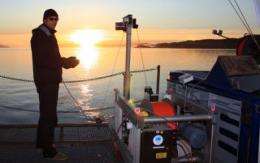Mathematical model may result in better environment measures for the Baltic

Eutrophication of the Baltic Sea has clear negative effects, such as dead bottoms and massive blooms of cyanobacteria. But high plankton production can also have positive effects on acidification. Researchers at the University of Gothenburg, Sweden, have shown that it is possible to work out the aggregate effects of various environmental measures.
"The environmental state of the Baltic Sea is affected by many different processes at the same time and on several different time scales. Mathematical models are the only tools that can determine the relative significance of such processes. I have helped develop a mathematical model for the marine systems of the Baltic Sea. Modelling tools of this type can and should make a contribution as a basis for decisions on environmental measures in the area," says Erik Gustafsson at the Department of Earth Sciences of the University of Gothenburg.
Since 1960 an average of 50 000 square kilometres of the deep water of the Baltic Sea has been characterised by a condition in which the level of oxygen is so low that higher life forms either abandon the area or suffocate. The area of oxygen-poor regions can vary significantly from year to year, but more than 100 years of measurements show that significantly better conditions prevailed overall in the deep water during the first half of the last century.
Oxygen conditions are governed both by natural processes and by human impact. Because of strong salinity stratification and limited water exchange through the narrow Danish straits, a large part of the deep water of the Baltic Sea is isolated for periods of time. At the same time, oxygen is consumed due to the decomposition of organic matter. As a result of human activities, the quantity of organic matter increased sharply during the second half of the 20th century.
"The overarching question in my thesis concerns the extent to which the deterioration in the environmental state of the Baltic Sea can be linked to changes in climate and to what extent the increased input of nutrients has influenced the situation."
Model results show that natural variations in climate are of great significance for the oxygen status of the deep water of the Baltic Sea over a time scale of decades. On the other hand, no clear effect can be observed over longer time scales. The marked deterioration in oxygen conditions in the deep water during the 20th century is instead largely due to our inputs of nutrients to the sea.
In addition to the physical, chemical and biological processes which are crucial among other things for the plankton dynamics of the area, Gustafsson has included the marine carbon system in his model.
"This means that it is now possible to calculate long-term variations in acidity in the sea. My model thus makes it possible to compare future positive effects of reduced nutrient inputs to the damping effect of eutrophication on acidification. This is an important issue, as the level of carbon dioxide in the atmosphere is expected to increase during the 21st century, and a sharply lowered pH may be of crucial significance to the ecosystem," says Gustafsson.
Provided by University of Gothenburg

















